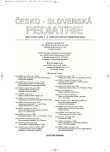Prader-Willi Syndrome in Newborns – Two Case Reports
Authors:
J. Kršiaková
Authors‘ workplace:
Oddelenie lekárskej genetiky MFN, Martin
primárka MUDr. J. Kršiaková
Published in:
Čes-slov Pediat 2008; 63 (10): 552-556.
Category:
Case Report
Overview
Prader-Willi Syndrome (PWS) belongs to rare genetic diseases. PWS is the best known genetic syndrome causing obesity. Clinical manifestation of the disease is complex. Clinical manifestations of the Prader-Willi Syndrome develop and conspicuously change in relation to patient’s age. It is a complex multi-system disease with prominent neonatal hypotonia, delayed psychomotor development low stature, problematic behavior, hyperphagia, a progressing obesity in the course of childhood, hypothalamic hypogonadism and characteristic facial dysmorphia. The disease is cause by the loss of paternal gene expression from chromosomal region 15q11-q13. Incidence of the disease is 1 : 10,000 to 1 : 25,000.
Early clinical diagnosis in the newborn in based on incomplete clinical picture. In the newborn period, unexplained severe hypotonia, disorders in food intake, weak or missing sucking reflex represent basic diagnostic criteria.
Key words:
Prader-Willi syndrome, hypotonic syndrome, newborn
Sources
1. Prader A, Labhart A, Willi H. Ein Syndrom von Adipositas, Kleinwuchs, Kryptorchismus und Oligophrenie nach Myotonieartigem Zustand in Neugeborenalter. Schweiz. Med. Wochenschr. 1956;86 : 1260–1265.
2. Polívková Z. Genómový imprinting a lidské patologie. Čes. - slov. Pediat. 2006;62(2): 102–105.
3. Bóday A, Maťoška V. Genómový imprinting. Čes.-slov. Pediat. 2000;55 : 33–40.
4. Seemanová E. Mikrodelečné syndrómy. Čas. Lék. čes. 2002;141 : 363–370.
5. Driscol DJ. The genetics of Prader-Willi syndrome. KIGS Biannual Report 2002;20 : 5–10.
6. Čapková P, Vrtel R, Šantavá A, et al. Molecular genetic study of causes of the Prader-Willi and Angelman syndromes. Čas. Lék. čes. 2005;144 : 113–118.
7. Schinzel A. Catalogue of Unbalanced Chromosome Aberrations in Man. Second Revised and Expanded Edition. Berlin, New York: Walter de Gruyter, 2001 : 629–638,665–668.
8. Gunay–Aygun M, Schwartz S, Heegee S, O´Riordan MA, Cassidy SB. The changing purpose of Prader-Willi syndrome clinical diagnostic criteria and proposed revised criteria. Pediatrics 2001;108: E92.
9. Holm VA, Cassidy SB, Butler MG, Hanchett JM. Greenswag LR, Whitman BY, Greenberg F. Prader-Willi syndrome: Consensus diagnostic criteria. Pediatrics 1993;91 : 398–402.
10. Vercesi A, Carvalho MRS, Aguitar MJB, Pena SDJ. Prevalence of Prader-Willi syndrome and Angelman syndrome among mentally retarded boys in Brazil. J. Med. Genet. 1999;36 : 498.
11. Paro-Panjan D, Neubauer D. Congenital hypotonia: is there an algoritm? J. Child. Neurol. 2004;19 : 439–442.
12. Varela MC, Kok F, Setian N, Kim CA, Koifmann CP. Impact of molecular mechanisms, including deletion size, on Prader-Willi syndrome phenotype: study of 75 patients. Clin. Genet. 2005;67 : 47–52.
Labels
Neonatology Paediatrics General practitioner for children and adolescentsArticle was published in
Czech-Slovak Pediatrics

2008 Issue 10
Most read in this issue
- Henoch-Schönlein Purpura from the Standpoint of Preventive Corticoid Administration
- Assessment of Clinical Signs of Intracranial Hypertension in Newborns and Infants with Hydrocephalus in Relationship to the Indication of Drainage Procedure
- Heterotopy of Stomach Mucosa – Review of Literature and Our Experience
- Prader-Willi Syndrome in Newborns – Two Case Reports
